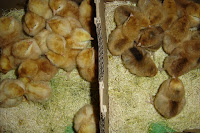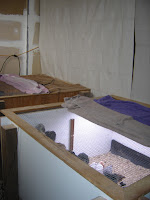The chicks we picked up in February are almost six weeks old. Of the 71 we received, 70 have survived, and we have them in a large grow-out space now, protected from the elements but, at the same time, giving them "la luz natural" so that they will be all ready for coop living next week. We still have some large warmers in place for those that are still not quite ready for chilly nights. When it rains, it is kind of chilly too. But, they are having a blast in their temporary space.
In the meantime, my two Golden Comets were approaching their second year, so I sold them to a local farm and picked up three Comet pullets that are just now starting to lay. That was a few weeks ago. I just finished up the quarantine and have shifted them into the flock. Moved the entire flock on fresh grass, stocked them up with grit and oystershell, filled their waterers with vitamin supplements, and filled the feeder full to ensure that they all lack for nothing, reducing the chances of any major fights. Each day, I go out with treats. Yesterday was sunflower seeds. Today, they received strawberries.
About two weeks ago, I noted that one of my hens was under the weather, her crop was all bloaty and I felt a larger than typical lump in her crop. I isolated her with water and nothing else to eat for the night. The next day, the bloaty was less but the impact felt like a bunch of rocks, was not very squishy, and she had not poohed. We squirted 5cc of olive oil into her (by mouth) for two days and tried massaging the mass. In the meantime, I picked up monistat 7 (linked to article as potential treatment) to treat the sour crop. When I knew she was finally poohing again, I gave her a little grit to help with digestion. The family has been working together for treating her every day.
She obviously has an impacted crop still (but much better) and had sour crop (seems to be gone). We treated the sour crop with monistat 7 giving her .5cc per day (no oil during this treatment) for seven days. The mass continued to decrease in size, and gradually got softer. Keeping her water medicated with vitamins, and tried a variety of soft foods to help her digest the mass while, at the same time, keeping her nourished. She liked the prescription canned catfood for a couple days, then turned her beak up at it. Tried mashed cooked vegetables... not wanted. Tried mashed fruit we had frozen in the freezer. She ate a little, and poohed a little, but, it was obvious there was not a lot of nourishment with the fruit.
Read about how to ferment chicken food and since we have chicks, we have the 20% protein chick start available. Fermented the chick start for three days and it was a hit. I didn't want to give her too much on the first day, but yah. She poohed a lot of the mass that keeps getting a little smaller and softer each day. After a week, we were done giving her the monistat, but we added olive oil to the remaining fermented food that we had stored overnight in the fridge. Takes about three days to ferment and we have a small "running" production of fermented feed going now. On the second day with the fermented feed, we warmed the mash a bit, added 5cc of olive oil and gave her about three level tablespoons of the stuff. She poohed right away, and so I gave her two more tablespoons in the afternoon. She eats it quickly, and has perked up quite a bit. Like I say, this has been two weeks worth of treatment and we are not done yet. There is no evidence of any sour crop or bloating, so I think we are just working on getting that mass to digest.
And I will note, that early on, twice, we almost culled her because she was in so much distress. Several sour crop and impacted crop articles indicated that the only way to "unbloat" her was to tip her upside down to let the stuff drain out. But I had read just as many articles about the fact that if this is done incorrectly, the chicken can accidentally get fluid into her lungs and die a painful death. I will admit that it took a couple of days for the bloating to go away by not feeding any more food, and only giving her water the first two days. Giving her the oil at the beginning of each day, then massaging the mass several times per day helped move things along to the point that she could pooh, and once the pooh started happening, we knew we were on the right track. When she ate the catfood and then ate the grit, we felt a huge relief. Prior to that point, the first few days, each time we assumed we had hit a wall and that she was suffering more than necessary, we would get things ready to cull her, only to come back to see an amazing rebound on her part. She told us, indirectly, that she was NOT done yet!
There are no vets in the area that treat chickens. There are some that treat "exotics" but even those are hesitant to treat chickens. Plus, cutting open the chicken to get the impact out is no guarantee for survival and is very expensive for a chicken that, at the most, is about $50 to replace. But, my main concern was to minimize her suffering as much as possible. She IS much better, her coloring never got too bad, plus, her eyes never dulled during all of this. So, I'm just watching her closely and working on her, day by day. Today, she too received a fresh strawberry as a treat along with her fermented mash with a squirt of olive oil. She is poohing a lot of "green" which, I assume, indicates that, day by day, she's getting rid of a mass of "grass" in her gut. Slowly, but....
UPDATE: 4/1/24 I checked on the hen again (like normal) to massage the mass and decide what to try giving her today, to feel an empty crop. Nothing was stuck in there today! Now to wean her back onto her regular pellets. Today and tomorrow, I'll still feed her the fermented chick feed. Then will give her some all purpose poultry pellets on Wednesday and Thursday to see how she does with digesting those. If all goes well, will give her some oyster shell so that we can get her back into the flock and no longer keep her in isolation. Wanting her to be back on track before that.
Then, on top of everything else, our brown duck came up lame again this spring. Last year was mid-April, I believe, that occurred after an April snow/ice storm. This year, we have had a lot of cold rain that just puddles out in the field, making for a very sloggy pasture space. The chickens, at least have cover over their pen, but that's not an easy option for the duck corral, short of making them stay inside their coop every day. So, yah, the start of bumblefoot for the duck on the other foot this year.
Normally, March is the last of the freezing temps, but in 2022 and 2023, mid-April brought in some really cold temps with snow. Hoping we don't get that this year! Too many plants have green buds on them already. Throwing out fertilizer around all the trees, shrubs and fruit bushes. I would hate to lose any of them again! I have a lot of sheets and covers this year, though, as a Just In Case, but the baby trees out in the field are just too many to cover!
About a little over half of the chicks will be going to new homes next week and then we will be down to raising the rest to the 10 weeks stage, integrating some into our flock while the rest will go to their new homes. I totally oversold the Color Pack Blue Layers I had ordered (they were popular) so I will be brooding a new batch of the Color Pack in mid-April specifically for our flock. In August, I'll thin out the older flock and keep about a dozen of the new gals for eggs.



















